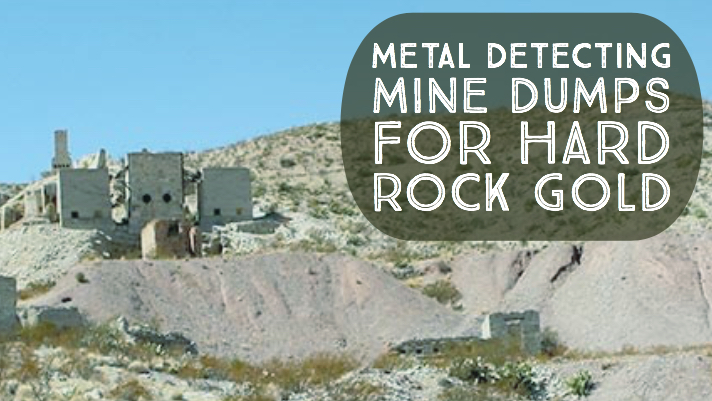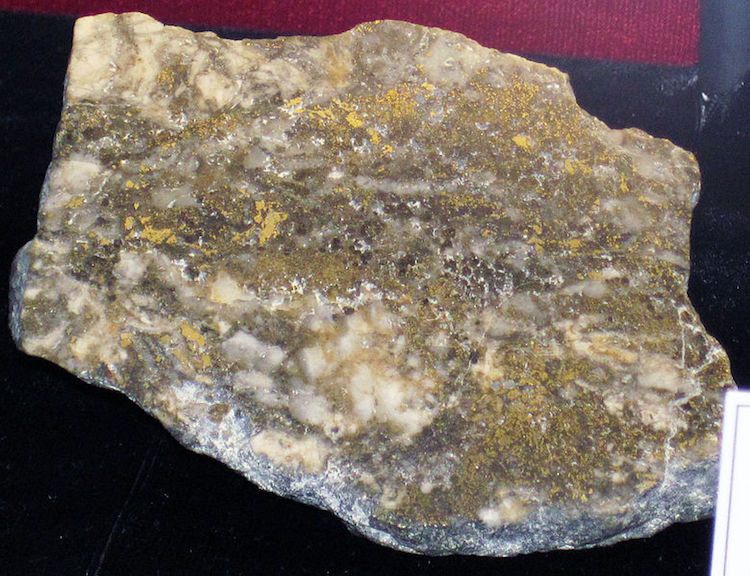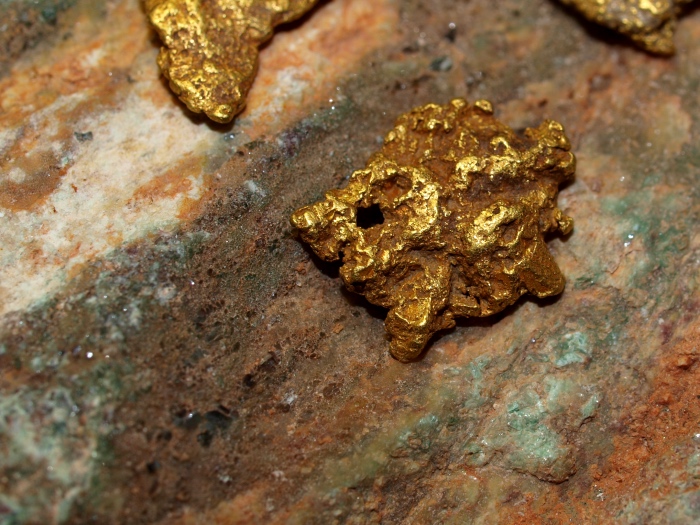
Old hard rock mine dumps are often overlooked by prospectors, who often gravitate toward the placer deposits in creeks and rivers rather than hillside deposits.
This can be a mistake. Even though a lot of mine dumps will be unproductive, some of them can be very rich if you learn how to hunt them correctly. A person can use many different methods to recover gold from the old dump sites, but metal detecting might be the most productive.
Your main challenge is finding detectable gold.
Challenges with Detecting Mine Dumps
There are easily thousands of mine dumps scattered around the West. These are the places where miners piled up what they considered to be “waste material” as they dug into a hillside as the followed a gold vein.
We’ve broken down 6 main difficulties you will encounter when detecting for hard rock gold in mine dumps. We will discuss these below.
1. Most of these gold veins are very small.
It is rare for a vein of gold to be thick and chunky. More often what the miners were chasing into the hillside were tiny, hair-thin gold stringers. They had to extract and crush a lot of ore to recover appreciable amounts of gold.
This means that the old-timers often discarded gold-bearing ores in their waste rock piles. This is good, because it is still sitting there waiting to be found. The difficulty is that a small stringer of gold may be too small to be found with a metal detector. If the veins are thin, or particles are disseminated and scattered in tiny particles then they will be difficult for you to recover.
If you want to successfully recover gold with your detector, you will need to locate mines that produced coarse gold.

This is a slab of gold in quartz from a mine in Montana. Note how the gold is fine and thin. There is a lot of gold in this specimen, but it is not solid chunks of gold – rather it is many fine disseminated veins scattered throughout the piece.
2. Troubles with Trash
Another major challenge with detecting old hard rock mines is the abundance of trash that they usually contain. Quite often these mines operated for decades, yet they did not have a regular garbage service back then! The result is massive amounts of metal trash that you will need to sort through to get to the gold.
Trash will vary from site to site. The amount of old blasting caps can be completely overwhelming at some mines and make them almost undetectable. You will also find bullets, wire, square nails, and all sorts of rubbish. A patient prospector can overcome even the trashiest sites, but sometimes its simply too much and inefficient to work with a detector.
If you find a mine dump that is exceedingly trashy, I recommend that you use a good VLF detector that has a good discrimination so that you can reduce the amount of rubbish that you have to dig.
TIP: Using a rake and a magnet to scrap away the surface layers of an area that you plan on detecting can work great to remove a lot of the surface trash before you ever turn on your detector.
3. Pesky Hot Rocks
Almost as troublesome can be hot rocks, which are individual rocks that sound off very much like they are metal. Often they are rich with iron or other substances that will mimic the sound of gold.
Most of the time you can learn to hear the difference between hot rocks and actual metal targets, but it does take some experience. In particular you will need to learn the sounds of your metal detector which only comes with time. Pulse induction detectors will handle hot rocks better than VLF detectors, but the flip side is that they don’t have very good discrimination (many don’t have that feature at all) and as such you will have to dig all trash.
4. It’s not a Gold Mine at All!
Its worth noting the importance of researching a mine before you bother taking the time to go out there and search it with your metal detector.
There are many different types of mines out there that extracted a lot of different minerals. Is it even a gold mine? They might have been digging for lead, silver, molybdenum, magnesium, copper, cobalt, or any of dozens of types of minerals. Only research will tell you if that mine actually has potential to have any gold at all.
And while you are doing your research, this would be the time to try and determine what type of gold they were mining for, and if it is coarse enough to be found with a metal detector.

5. Waste Pile or High-Grade Ore Pile?
When the miners were digging into a hillside chasing a vein, they had to remove enough material to make a tunnel. As such, a lot of that material was not part of the vein, but rather it was simply “waste rock” that had little to no value. This rock would be piled somewhere near the mine entrance, and generally it is of low value.
On the other hand, miners would also sort out the high-grade ore that was part of the vein they were working. This material would also be piled up, but it was separated from the waste rock. This would generally be shipped out for processing because many mines did not have the infrastructure in place to process these ores.
Sometimes these high-grade piles never left the mine. Often the mine ceased operation and never bothered to process the last of the ores. This ore might not be super rich, but it may have detectable gold in it.
6. Safety Concerns
Anytime you are working around old mines it is worth mentioning the need for safety. It can be awfully tempting to go into those tunnels and explore, but I encourage you to keep out of those mines if you want to stay alive! There are lots and lots of danger that you can encounter underground.
Even if you stay out of the tunnels, you should be aware that there may be hidden adits that may be covered with brush or debris that you could still fall into. Along with that, there is also rusty junk all over and various things that could ruin your day if you stepped on it. Be careful and work slowly around old mine.
Successful Detecting at Gold Mine Dumps
Most prospectors seem to avoid hunting around old mines, but the truth is that these are some of the best places left to recover good gold with a metal detector. Since there are so many challenges that you will face when hunting them, lots of people just avoid them completely.
That’s good for you, if you persevere and are willing to give it a try. Even the most patient prospector will be tested hunting old mine dumps because you will find that even if you follow all the tips above, the gold is still hard to find.
Most successful prospectors I have met who hunt at mine dumps use a very sensitive detector like the Minelab GOLD MONSTER 1000 because not only does it have good discrimination, but it also will find those specimens with very thin, wiry gold in them.
Next: Detecting for Big Gold Nuggets & Specimens in Tailing Piles
Also Read: Metal Detect the “Fringe” Spots to Find More Gold Nuggets


